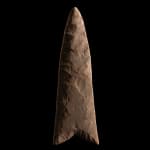Egyptian
An Egyptian flint fishtail knife, Predynastic, Naqada I-II, circa 4th millennium BC
Flint
Length: 16.5 cm; width: 5.3 cm
Further images
The blade is knapped from a creamy beige-hued flint with cutting surfaces to all sides, including two prongs at one end, the other end is knapped to a point.
The blade is knapped from a creamy beige-hued flint with cutting surfaces to all sides, including two prongs at one end, the other end is knapped to a point.
Provenance
Hans Blaser Collection, Kloten, Zurich, acquired in the 1970s
With Galerie Nefer, Zurich, 1991
Private collection, Switzerland, acquired from the above
Exhibitions
On Loan: Antikenmuseum Basel & Sammlung Ludwig, 1998 - 2022Literature
This implement appears to be an early form of the pesesh-kef, a ritual implement used during the 'Opening of the Mouth' ceremony. The long, pointed end would have been inserted into a handle and the V - or fishtail-shaped side would have been used as the cutting edge. There is evidence that these knives were used at birth to cut the umbilical cord and was placed in the grave to assist its owner's rebirth into the afterlife. Although these flint knives are rare after the beginning of the 1st Dynasty, models of the implement, the typical pesesh-kef, are known from Old Kingdom tombs and continue to occur occasionally as late as the Eighteenth Dynasty.The 'Opening of the Mouth' ceremony took place during the funerary process, both on the mummy and statues of the deceased. The ritual was intended to enable either the deceased or the temple statue to breathe in the fragrances of fresh-cut lotus flowers, incense, and anointing oils, as well as to magically ingest offerings of food and drink on the temple altar or in the tomb. For discussion of the pesesh-kef, see R. van Walsem, 'The psš-kf. An investigation of an ancient Egyptian funerary instrument', OMRO, 59, 1978, p. 231, table 7, p. 224, 5; A.M. Roth, 'The Psš-kf and the "Opening of the Mouth’ Ceremony"', JEA, vol. 78, 1992, p. 113ff.
For further analysis of these Predynastic flint knives as 'possible ancestors' of the pesesh-kef, see T. Hideke, 'Getting the ritual right—fishtail knives in Predynastic Egypt', in S. Meyer, (ed.), Egypt - Temple of the Whole. World Studies in Honour of Jan Assmann, Numen Book Series, vol. 97, pp. 137-151. There is a similar example of a fishtail knife in the Metropolitan Museum, New York, acc. no. 16.2.4. Also see L. M. Berman, Catalogue of Egyptian Art: The Cleveland Museum of Art, New York, 1999, pp. 117-119, nos. 62-64.
5
of
5







